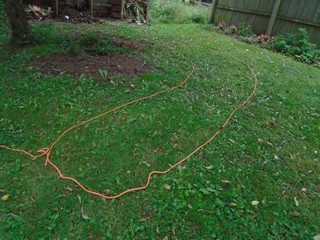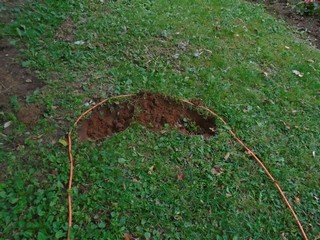A Shrub Bed to Front the Compost Pile
My wife thought that the compost station removed some of the look of the garden and it would be good to shield it off from sight. So in the fall of 2015 I made a bed with forsythia and daphne taken from plants I had started.

As you step out of our house to the patio and look east toward the compost bin, you see just that, the compost area. A lot of the time I have stuff gathered there waiting to become compost or to be scattered on the garden or whatever, and my wife tends to think this can be a eyesore. She is of course correct unless you are a composting fanatic and we are few and far between. The cost of a fence being somewhat prohibitive, I proposed putting in a shrubbery bed instead. I had started some forsythia bushes from a large one we have and some daphne had self seeded so I had some good stuff to work with.

I began by marking off the rough area of the bed with rope. It allows for easy changing of the mind and for checking such things as making sure that there is room between flower beds, trees and other reasonably permanent structures so that one can get a garden cart or similar item through without running over a plant.

While there are many opinions of how to dig a bed, I like to do it by hand especially because I own a shovel and not a tiller. I like to single dig a bed and bury the sod as I go. In the past I have double dug beds and I think they are more to impress other gardeners rather than plants. Plants grow very well in 8" deep pots full of good potting material. They well do at least as well in 8" of good soil. You just have to make sure the soil is good. I begin to dig by removing a trench of soil at one end of the marked area and moving it to the other end.

The removed soil is laid at the outside of the far end of the bed. when the digging reaches this end, the soil will be used to fill the last trench. If you have never single dug a bed, this will make sense as we go along.

Standing facing the first trench made by removing the soil to the other end, another trench is begun by driving the shovel, in this case freshly sharpened, to its depth into the ground, about 8" deep. the soil is flipped into the other trench so that the sod is buried. I am digging this bed in the fall and chances are that the sod will not make its way to the surface before freezing weather sets in. There are millions of weed seeds in a shovel full of earth and I am not worried about a bit of grass that may survive a burial. Most of it will just compost and feed the new shrubs.

The digging goes fairly quickly except for the removal of a few tree roots. Heavy clippers are needed for this and should be sharpened when finished the bed. Ground around the roots quickly dulls the cutting edges of the clippers. At the end of the bed that soil from the first trench fills the last, sod down and composting. Now it is time to get some shrubs for the new bed.
